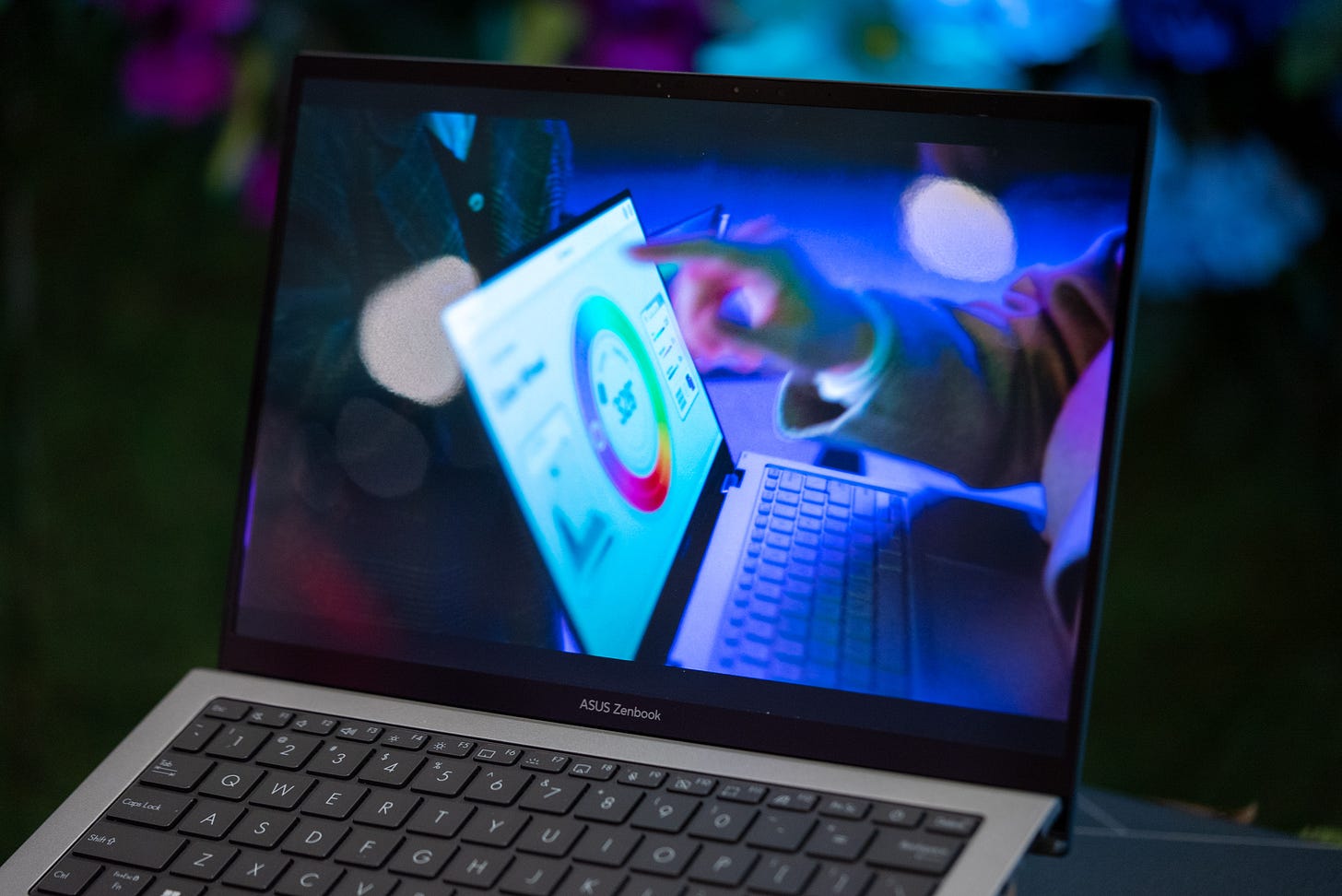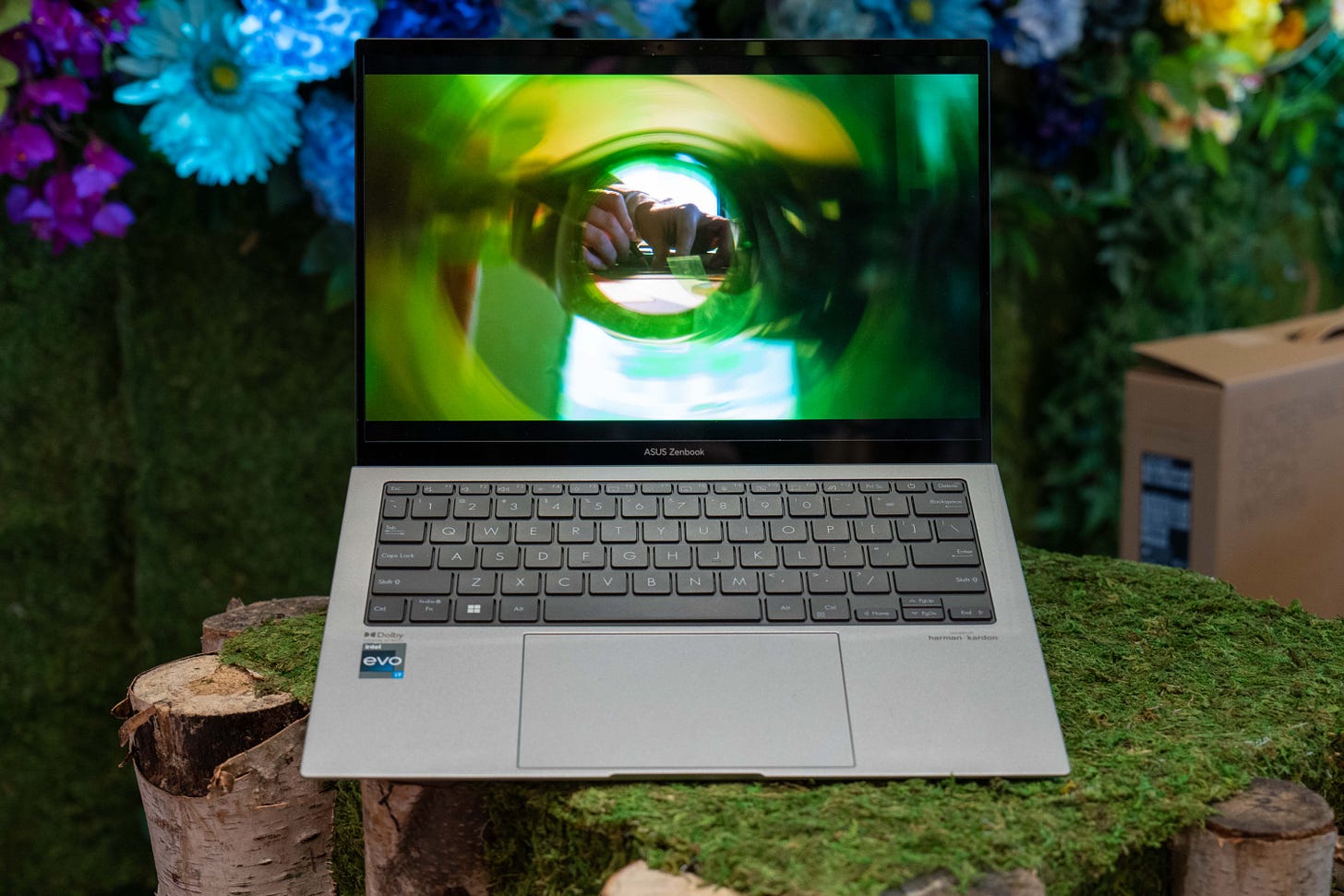Asus ZenBook S 13 (2023) hands-on review: impressively lighter than the MacBook Air
I tested the new sustainable Asus ZenBook S 13 that's thinner than Apple's MacBook Air M2, yet it includes full-sized HDMI and USB-A ports, and two USB-C ports
Pros
✅ 💻 Impressively thin and light making the MacBook Air feel hefty
✅ ⚙️ Stacked: Intel Core i7 13th gen CPU. Up to 32GB RAM & 1TB SSD
✅ 📺 13.3-inch OLED, 2.8K resolution and a 180° lay-flat hinge
✅ ♻️ Recycled metals & plastics for an eco-friendly, yet durable design
✅ 🔋 Promises 14 hours of battery life plus USB-C Easy Charge
Cons
❌ 💰 $100 more than last year’s launch price
❌ 👇 No touchscreen and dialed back 550 nits peak brightness
The Shortcut hands-on review
There’s a little bit less to this year’s Asus ZenBook S 13, and that’s actually a good thing because it’s just 1cm thick and weighs only 2.2 lbs. This impressively thin-and-light laptop makes my MacBook Air feel hefty, yet it includes more ports.
With the ZenBook S 13, it’s almost as if Asus is boasting that a full-featured Ultrabook can’t possibly get much thinner than this.
What struck me is the full-sized HDMI and USB-A ports that Asus engineers managed to fit into the ZenBook S 13 – they hardly fit within the thin frame. In fact, the frame is designed with a little divet around the corners of the HDMI port. It’s almost as if Asus is boasting that a full-featured Ultrabook can’t possibly get much thinner than this.
At $1,399 from stores like Abt, it starts at $100 more than last year’s ZenBook S 13 and there’s no touchscreen option this time around. But this Intel 13th gen-powered Windows 11 laptop is smartly and sustainably built, enough that it may land on our best laptops list when we get more time to test it in full.
Asus ZenBook S 13 (2023) specs
💰 Price: $1,399.99
📺 Screen size: 13.3-inch (16:10 aspect ratio)
🖥️ Resolution: 2.8K OLED (2880 x 1800) with Dolby Vision
💡 Brightness: 550 nits
📸 Web camera: Full HD
⚙️ CPU: Intel Core i7-1355U
🐏 RAM: 32GB (LPDDR5 5200 MHz)
🗄️ Storage: Up to 1TB SSD
🔋 Battery: 63Wh
🔌 Charger: 65W (included)
📶 Connectivity: WiFi 6E (802.11ax) + Bluetooth 5.2
🖱️ Touchpad: Yes, 129 x 81mm
👇 Touchscreen: No
📐 Dimensions: 296.2 x 216.3 x 10.9mm
⚖️ Weight: 2.2lbs (1kg)
🌈 Colors: Ponder Blue, Basalt Gray
🪟 OS: Windows 11 Pro
Asus ZenBook S 13 price
💰 Value prop. There’s value to the new ZenBook S 13 (2023), even if it’s $100 more than last year’s laptop at launch. That’s because Asus has packed its 13-inch laptop with a top-shelf Intel Core i7-1355U CPU that’s previously been reserved for 15-, 16-, and 17-inch laptops and it’s been engineered to be thin, light and sustainable with few sacrifices.
🤼 Rival to the MacBook Air’s price. You can get a MacBook Air for $999 with Apple’s M1 chip or $1,199 with the M2, but the more comparable configuration starts at $1,499 or higher. So Asus’ price of $1,399 isn’t exactly a steal but doesn’t feel completely unreasonable if you’re looking for a Windows laptop alternative to what Apple currently has on sale.
Asus ZenBook S 13 design
🪶 Thin-and-light. I know it’s an overused phrase in tech, but the ZenBook S 13 feels impossibly light. It’s 30% slimmer than the previous generation and, frankly, if I pick up any laptop in 2023 and immediately notice it’s lighter than my MacBook Air, that’s remarkable.
🔌 Ports-galore. The frame is so wafer-thin that it hardly fits the USB 3.2 Type-A port, full-sized HDMI 2.1 port and 3.5mm headphone jack. You can see in our hands-on review photos that their outlines almost intrude on the perimeter of the frame. Laptops can’t get much thinner than the ZenBook S 13.
There are also two Thunderbolt 4 USB-C ports on the left side and they support fast charging, 4K external displays, and up to 40Gbps transfers. I don’t love having a pair of USB-C ports only on one side of a laptop (when they’re on either side, it helps to have the option to plug in on the left or right side in tight situations), but I get that it’s easier to couple I/O ports.
♻️ Colors & Recycled materials. ZenBook S 13 colors include the classic Ponder Blue and the all-new Basalt Gray, the latter is extra eco-friendly thanks to its unique-looking, Earth-friendly plasma ceramic aluminum lid. Both colors use recycled materials and plastics – the speakers and keycaps use post-consumer-recycled plastics while the speakers also use ocean-bound plastics, according to Asus – and come in 100% recycled packaging.
📐 180-degree ErgoLift lay-flat hinge. OK, it’s thin, it’s light, it’s environmentally friendly and it’s full of ports. But have you seen this laptop lie down? Its final design trick is that it can be laid at almost any angle within 180 degrees thanks to an impressive hinge. That same hinge also gently lifts the whole laptop so it always sits at a comfortable typing angle.
⌨️ Make or break on Windows laptops. The keyboard feels comfortable with large keycaps that have 1.1mm key travel and a 0.1mm dish to them. There’s also a large Asus ErgoSense touchpad that I want to spend more time with. It measures 129mm x 81mm and has an anti-fingerprint coating and multitouch gesture support. Apple’s MacBook line has had the gold standard for touchpads for me – and I’m interested in testing out the ZenBook S 13 more to see if I like this one just as much.
Asus ZenBook S 13 specs
⚙️ Intel inside. Instead of the AMD Ryzen 6000 series that we saw last year, Asus is outfitting its new ZenBook S 13 with an Intel CPU. It’s the first time we’ve tested a 13-inch laptop with the Core i7-1355U, a U-series 13th-gen Intel processor announced at CES 2023 and previously seen in larger 15-, 16-, and 17-inch laptops with a trio of 14-inch HP laptops only getting it recently. Asus is packing a 10-core chip (2 performance, 8 efficient cores) into a very thin-and-light frame.
📈 Performance tests. Stay tuned for in-depth performance tests to see how well the Intel Core i7-1355U can dissipate heat and how the Intel Iris Xe graphics handle various games – but the specs on paper are good for travelers who want something compact yet powerful enough for multitasking. We’ll have to see how it compares to the AMD Ryzen 7 6800U found in last year’s Asus ZenBook S 13 laptop. The fact that it has up to 32GB of storage this time (up to 16GB) may help in benchmarking.
Asus ZenBook S 13 display and sound
📺 OLED eye candy. Asus refers to its ZenBook S 13 display as a 2.8K OLED HDR NanoEdge, which is a fancy way of saying that the screen has excellent black levels, a satisfying 2880 x 1800 resolution, a solid 85% screen-to-bezel ratio and almost all of the visual certifications (and brand stickers) that you can fit on a laptop: Dolby Vision, 100% DCI- P3 color gamut, VESA DisplayHDR 500 True Black and Pantone Validated. I appreciate the 16:10 aspect ratio (the only correct aspect ratio for laptops), too.
💡 Brightness, but not brightest. The ZenBook S 13 doesn’t have a touchscreen (at least the one I tested didn’t), and the peak brightness was 550 nits – good but not the best we’ve seen from Asus. Last year’s configuration was 550 nits with a touchscreen and 600 nits without one. It seems like there’s a non-touch OLED at the lesser of the two values. But, hey, it’s still brighter than the 500 nits from a MacBook Air M2.
🔈 Speaker alliance. The ZenBook S 13 has both a Harman Kardon-certified audio system and Dolby Atmos with a smart amplifier. Having two audio leaders onboard is a plus, and there’s Asus’ own audio booster technology to raise the volume by up to 5.25x, according to the company.
Asus ZenBook S 13 battery life
🔋 Battery testing fine print. Asus touts 14 hours from the 63Wh ZenBook S 13 battery as well as promising improved cooling over last year’s sometimes hot model. It’s a solid number, even if Apple’s M2 MacBook Air beats it by four hours. That said, Asus admits its internal battery performance tests were done when the resolution was 1080p, so you may get a bit less at the full 2.8K resolution.
🔌 Asus includes a 65W charging adapter with the laptop and the Thunderbolt 4 USB-C ports support fast charging. It’s the reason I like having USB-C on either side – you can charge from the left or right, but alas, that option isn’t on many thin laptops.
Should I buy the Asus ZenBook S 13 (2023)?
Yes, if…
✅ You want a thin-and-light laptop puts the MacBook Air to shame
✅ You appreciate a crisp-looking 13.3-inch OLED laptop screen
✅ You care about owning a sustainable laptop made of recycled material
No, if…
❌ You need more gaming oomph on the level of an Asus ROG laptop
❌ You desire a touchscreen laptop like last year’s ZenBook S 13
❌ You need more than 14 hours of battery life at 1080p











